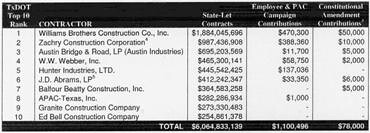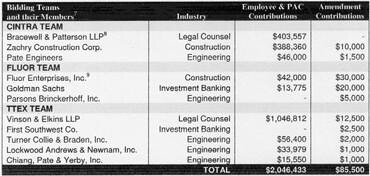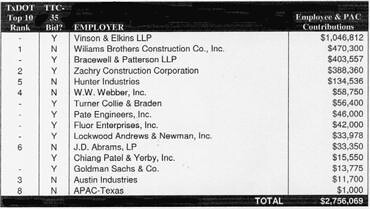 Big Money Paves the way for the Trans-Texas CorridorHow Big Money Bought Texans the Nation's Most Expensive Toll Road Project
Big Money Paves the way for the Trans-Texas CorridorHow Big Money Bought Texans the Nation's Most Expensive Toll Road ProjectMay 12, 2005
Campaigns for People
Copyright 2005
The Texas Department of Transportation (TxDOT) calls it the "Trans Texas Corridor".
Others, including Time magazine, are questioning whether it might better be called a "big, fat Texas boondoggle".
Whatever you call it, few Texans know that the Trans Texas Corridor (TTC) is the nation's biggest toll road project and that it was paved with big campaign contributions. The TTC is 4,000 miles of 10-lane divided toll roads plus high speed rail, freight rail and utilities spanning from Mexico to Arkansas, New Mexico to New Orleans, and skirting every major city in between. It's estimated to cost up to $183.5 billion dollars.
It's to be built with extremely limited public oversight. Except for the corridor cast and roughly parallel to Interstate 35 (TTC-35), it's a road system most Texans can hardly imagine will ever be built.
But road builders and toll bond financers from around the world are lining up to participate. These interests contributed $166,000 to amend Texas' constitution and more than $2.7 million in Texas' last two elections to turn the nation's largest toll road project into a reality.The Big Money Players in Texas Road BuildingBig money has played a major role in rewriting state laws to make the TTC and local toll road projects possible.
Over the past four years, road building and bond financing interests have given millions of dollars to support amending Texas' constitution and to pass laws that will create the TTC. This report examines only a portion of the total: $2.9 million in political contributions by the top 10 TxDOT contractors (TxDOT Top 10), entities that bid on the TTC-35 toll corridor (TTC Bidders), and their employees and related PACs. (1)
In the period spanning January 1, 2001 through December 31 2004, TxDOT awarded over $14.3 billion dollars in contracts to build and maintain roads in the state of Texas. More than 40% of this total (over $6 billion) went to the TxDOT Top 10. (2) In this same time period, the TxDOT Top 10 gave over $1.1 million in political contributions.
Contributions to Executive and & Legislative Candidates by Employees & PACs Representing the TxDOT Top 10: January 1, 2001 – December 31, 2004
The TTC Bidders followed the same pay-to-play pattern of big campaign contributions as they pursued the contract for TTC-35, the largest stretch of toll corridor under construction in Texas to date. This corridor runs north-south roughly parallel to 1-35 through rural land, starting east of San Antonio and ending northeast of Dallas. The cost of a 400 mile round-trip is expected to cost between $25 and $80 in tolls. (6) From January 1, 2001 through December 31, 2004, employees and PACs of bid participants contributed over $2 million dollars to candidates for executive and legislative state offices; those same entities gave another $85,500 to promote amending Texas' constitution. TxDOT awarded the TTC-35 contract to the CINTRA team in December of 2004.
Members of the CINTRA team gave executive and legislative candidates for state office over $800,000.Contributions to Executive and & Legislative Candidates by Employees & PACs Representing the TTC Bidders: January 1, 2001 – December 31, 2004
What Big Road Money Sought: Propositions 2 and 15 in 2001Big money funded the campaign in 2001 to pass constitutional amendments authorizing the financing mechanisms behind the TTC. Together, Propositions 2 & 15 were touted as the way to buiid more roads more quickly without increasing existing taxes. Road building interests established the "Yes on 2 & 15 PAC" and quickly amassed over $400,000 in support of these constitutional amendments. Five of the TxDOT top 10 contractors gave $70,000 to the campaign. TTC Bidders gave $58,000. In total, the TTC Bidders and TxDOT Top 10 gave $123.000 or over 30% of the money used to Finance the Yes on 2 & 15 PAC. (10)Contributions to "Yes on 2 & 15 PAC" by TTC Bidders and the TxDOT Top 10: August 2001 through November 2001 Proposition 2
Proposition 2 marks the first time Texas has issued bonds to pay for roads. (11) This shift away from a pay-as-you-go approach to highway construction was sold to the public as the best way to finance road construction in Texas' disadvantaged border colonias.
Few Texans knew that it would become a mechanism to fund the TTC and other mega-toll road projects across the state.Proposition 15 created the Texas Mobility Fund and authorized grants and loans for state highways, toll roads, and "other mobility projects."
There was no public mention at the time that "other mobility projects" would include the TTC. Rather, the public understood that the Texas Mobility Fund was a way to transfer existing state revenue from gas taxes and automobile fees into a start-up fund to underwrite highways bonds for additional highway projects (including toll roads) without raising existing taxes.
Big Road Money in the 78th Legislature: House Bill 3588While Propositions 2 & 15 planted the seeds for Texas' massive toll projects, HB3588 brought those projects to fruition during the 78th legislature (2003). House Bill 3588 granted the state the broad, new powers needed to build the TTC by amending Texas' Transportation Code:1. The state has new and expanded powers for acquiring public- lands for the purpose of building the Trans Texas Corridor. "...the commission has the same powers and duties relating to the condemnation or purchase of real property..." [Sec. 227.04(a)] A facility includes a turnpike (toll road) project.2. The state may privatize any existing public road. "The commission by order may convert a segment of the free state highway system to a turnpike project and transfer that segment to an authority, or may transfer an existing turnpike project that is part of the state highway system, whether previously tolled or not..." [Sec. 370.035(a). (12)3. The state may convert any existing public freeway to a public or private toll road. "An authority may impose a toil for transit over an existing free road, street, or public highway transferred to the authority under this chapter." [Sec. 370.176(a)]12In the process of creating new financing mechanisms for building Texas highways, legislators re-wrote Texas' laws to the advantage of private corporations that will build, maintain and toll not only new roads as part of the TTC, but also existing and even partially-built public roads that may be "converted" into toll roads.These private entities also have unusually broad powers to grant concessionary contracts and determine the final location of highways according to the "Comprehensive Development Agreements" (CDAs). Comprehensive Development Agreements (CDA) are a tool utilized primarily by
third world countries whose governments do not have the ability to incur debt in order to build the infrastructure necessary for economic development. These governments negotiate with private partners (concessionaires) to build and operate the road infrastructure under the terms of the CDA. Private partners in these agreements utilize "revenue enhancers", terms negotiated in the CDA, to pay back their investment with a profit, such as tolls and taking additional right of way leased out by the concessionaire for private business development.
Under Texas' CDAs, the contracted developers will plan, design, construct, finance, maintain and operate all toll corridor facilities. (13) According to David Stall of Corridor Watch, "The State of Texas claims one of the top economics in the world, and should not need to allow a private partner to build and operate critical elements of our infrastructure." CDAs grant the developers decision-making authority to eliminate public input, purportedly in the interest of expediting projects.The TxDOT Top 10 and TTC Bidders gave generously to legislators who ultimately had a say over the content and passage of HB3588. These interests made over $2.7 million in campaign contributions from January 1, 2001 to December 31, 2004. These special interests steered more than half of this money to elected officials who either held statewide leadership positions in 2003 or who sat on key House or Senate transportation committees.
Recipients of Campaign Money from the TxDOT Top 10 and TTC Bidders: January 1, 2001 to December 31, 2004 All Contributions to Executive and Legislative Candidates for State Offices by Employees and PACof the TxDOT Top 10 and TTC Bidders: January 1, 2001 to December 31, 2004
All Contributions to Executive and Legislative Candidates for State Offices by Employees and PACof the TxDOT Top 10 and TTC Bidders: January 1, 2001 to December 31, 2004
More Big Road Money in 2003: Proposition 14Big money then financed the campaign in support of Proposition 14 in the fall of 2003. Certain features of HB3588 could only he implemented if Proposition 14 passed. Proposition 14 gave the state and TxDOT the ability to borrow money by any form of loan to fund highway projects, so long as the term of the loan does not exceed two years. Proposition 14 also authorized up to $3 billion in bonds for highway construction, to be guaranteed by future gas taxes. (14)
Contributions to "Yes on 14 PAC" by TTC Bidders and the TxDOT Top 10 and TTC Bidders: August 2003, through November 2003 Road building interests established the "Yes on 14 PAC" and quickly amassed $165,000 in support of this constitutional amendment
Road building interests established the "Yes on 14 PAC" and quickly amassed $165,000 in support of this constitutional amendment, including $12,000 in start-up funds from the Yes on 2 & 15 PAC. Three of the Top 10 contractors gave $8,000 to the campaign. TTC Bidders gave $52,000. In total, he TTC Bidders and TxDOT Top 10 gave $55,000 or over 33% of the money used to finance the Yes in 14 PAC. (15)
Propositions 2, 15 and 14 and House Bill 3588 provide the state with broad new powers and a variety of new ways to finance the nation's largest private toll system. Together, these changes to Texas' law enable what no single piece of legislation and no ordinary Texan sought; the construction of the $183.5 billion Trans-Texas Corridor.
The Public's ReponseIn June of 2004, Republican activists included a plank in their state party platform calling for the repeal of HB3588 and urging the state to rescind its broad new TTC-related powers. TTC critics worked with Representatives Garnet Coleman (D-Houston) and Robby Cook (D-Eagle Lake) in the 79th legislature
to propose a bill (HB3363) that would have placed a two-year moratorium on TTC-related projects to allow public input. HB3363 also would have prohibited converting existing state roads into toll roads. A protest at the capitol in favor of HB3363 drew some 500 activists from all across Texas. HB3363 was assigned to the House Transportation Committee on March 23, 2005 but never even got a hearing.MethodologyAll campaign contribution data in this study is compiled from reports that state candidates and PACs filed with the Texas Ethics Commission from January 1, 2001 through December 31, 2004. The compiled data was standardized and annotated, in part, by Tcxans for Public Justice.
As of September 2003, PACs and candidates were required to make their "best effort" to report the employer and occupation of contributors giving over $500, When not disclosed prior to September 2003, employment has been determined based on the best available information.
This study docs not include lobbyist contributions to candidates and PACs, unless the lobbyist identifies his or her employer as one of the TxDOT Top 10 or a TTC Bidder. Contributions to candidates for judgeships, Land Commissioner, Railroad Commissioner and the State Board of Education are not included in this study.
__________________________________________________________________
Footnotes
(1) According to Texas state law, corporations cannot make campaign contributions. Corporations can, however, sponsor a political action committee (PAC) and pay the PAC's administrative expenses. Corporations also can spend unlimited sums to support or oppose ballot measures, such as constitutional amendments.
(2) TxDOT open records requests: December 14, 2004 and April 7, 2005. See Appendix A.
(3) All constitutional amendment contributions in this report were made by corporate entities, not by their employees or PAC’s.
(4) $189 million of these contracts were awarded in partnership with Gilbert Texas Construction, L.F.
(5) $63 million of these contracts were awarded in partnership with the Granite Construction Company.
(6) "Rollin, rollin, rollin ..." Jack Smith, Fort Worth Star-Telegram, January 28, 2005
(7) Members of bidding teams where no contributions could be identified arc not listcd.
(8) The legal firms listed have many interests at the Legislature, representing and lobbying for many different industries.
(9) Fluor-related contributions to Texas candidates came from three sources: Fluor's California-based PACs (Fluor Corporate California PAC and Fluor Public Affairs Committee) and James T. Hackett, a member of Fluor''s board of directors.
(10) There was a $5,000 overlap of coniribulions from TTC bidders and the TxDOT Top 10.
(11) House Research Organizaiion on Proposition 2:
Authorizing bond issuance for access roads to border colonias.(12) http://www.corridorwatch.org CorridorWatch is a Texas non-profit corporation working to increase public awareness and understanding fo the Trans-Texas Corridor and its impact on Texas.
(13) http://www.keeptexasmoving/projects/development_agreement.aspx -- TxDOT's official web site on the TTC.
(14) House Research Organization on Proposition 14:
Allowing borrowing by the Texas Transportation Commission.(15) There was a $5,000 overlap of contributions from TTC bidders and the TxDOT Top 10. In addition, since the TxDOT Top 10 and TTC Bidders contributed to the Yes on 2 & 15 PAC. the use of Yes on 2 & 15 funds to initiate the Yes on 14 PAC increases their share of the total to over 35%.
___________________________________________________________________
Appendix A: State-Let Construction and Maintenance Projects: January 1, 2001 - December 31, 2004.
Appendix B: All contributions to Yes on 2 & 15 PAC.
Appendix C: All contributions by employees and PACs of the TxDOT Top 10 and TTC Bidders to all legislative and executive state candidates.
Appendix D: Contributions by employees and PACs of the TxDOT Top 10 and TTC Bidders to all legislative and executive state candidates sorted by recipient and itemized by contributor.
Appendix E: Contributions by employees and PACs of the TxDOT Top 10 and TTC Bidders to all legislative and executive state candidates sorted by contributor and itemized by recipient.
Appendix F: All contributions to Yes on 14 PAC.
______________________________________________________________
Appendix G: TTC-35 Toll Corridor Bidding Teams:
CINTRA TEAM
Cintra, Concesiones de Infraestructuras de Transporte, S.A. (CINTRA)
Zachry Construction Corporation
Ferrovial-Agroman
Earth Tech, Inc.
Price Waterhouse Coopcrs
JP Morgan Securities
Bracewell & Patterson
Pate Engineers, Inc.
Aguirre & Fields LP
Rodriguez Transportation Group
OTHON, Inc.
Railroad Industries Inc.
Amcy
Mercator
Public Resources Advisory Group
Southwestern Capital Markets
National Corporate Network
HRM Consultants
FLUOR TEAM
Fluor Enterprises, Inc.
Parsons Brinckerhoff
Edelman
Vollmer Associates, LLP
Goldman Sachs
Transurban
S&ME, Inc.
Rodrigucz Transportation Group
RJW Operations
TTEX TEAM
Trans Texas Express, LLC (TTEX)
Skanska BOT AB
Tclvcnt
Hensel Phelps Construction Co.
Chiang, Pale & Yerby, Inc.
Skanska USA Civil '
Turner Collie & Braden, Inc.
DMJM+Hams
Corgan
Morgan Stanley
First Southwcst Company
Lockwood Andrews & Newnam, Inc.
Hanson Wilson, Inc.
Nationwide Water Resource Services
W.P- Engineering Co., Inc.
Moreland Altobelli
Lea + Elliot
Cinnabar Service Company
Vinson & Elkins LLP
Shannon, Gracey, Ratiff & Miller LLP
Arredondo, Zapeda & Brunz, Inc.
APM & Associates, Inc.
Advanced Consulting Engineers
For an electronic copy of all appendices, please contact:
info@campaignsforpeople.org
(512) 472-1007
700 West Ave.
Austin, TX 78723
















